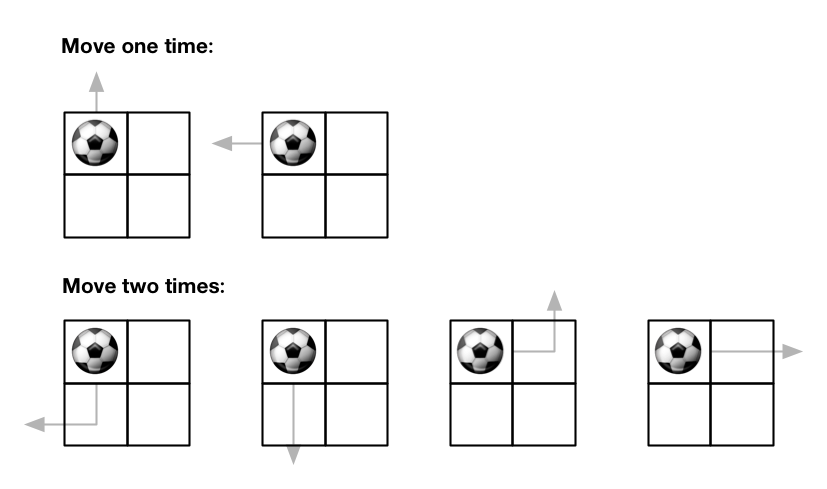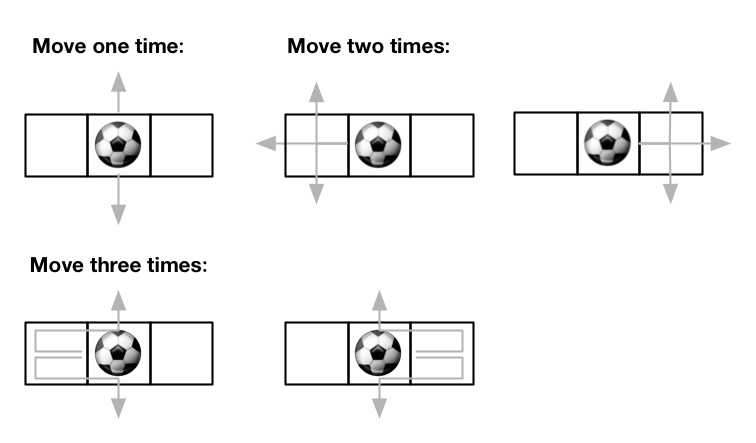- {x}
- Maximum Vacation Days
- Median Employee Salary
- Managers with at Least 5 Direct Reports
- Find Median Given Frequency of Numbers
- Subtree of Another Tree
- Squirrel Simulation
- Winning Candidate
- Distribute Candies
- Out of Boundary Paths
- Employee Bonus
- Get Highest Answer Rate Question
- Find Cumulative Salary of an Employee
- Count Student Number in Departments
- Shortest Unsorted Continuous Subarray
- Kill Process
- Delete Operation for Two Strings
- Find Customer Referee
- Read More...

Out of Boundary Paths
There is an m x n grid with a ball. The ball is initially at the position [startRow, startColumn]. You are allowed to move the ball to one of the four adjacent cells in the grid (possibly out of the grid crossing the grid boundary). You can apply at most maxMove moves to the ball.
Given the five integers m, n, maxMove, startRow, startColumn, return the number of paths to move the ball out of the grid boundary. Since the answer can be very large, return it modulo 109 + 7.
Example 1:

Input: m = 2, n = 2, maxMove = 2, startRow = 0, startColumn = 0 Output: 6
Example 2:

Input: m = 1, n = 3, maxMove = 3, startRow = 0, startColumn = 1 Output: 12
Constraints:
1 <= m, n <= 500 <= maxMove <= 500 <= startRow < m0 <= startColumn < n
Solution Explanation: Out of Boundary Paths
This problem asks to find the number of paths a ball can take from a starting position in a grid to move out of the grid's boundaries within a given number of moves. The solution uses dynamic programming with memoization to efficiently count these paths.
Approach: Depth-First Search with Memoization
The core idea is to use a recursive depth-first search (DFS) function to explore all possible paths. Memoization is crucial to avoid redundant calculations, significantly improving performance.
The dfs(i, j, k) function represents the number of paths to go out of bounds from position (i, j) with k moves remaining.
-
Base Cases:
- If
(i, j)is out of bounds (i.e.,i < 0ori >= morj < 0orj >= n), we've left the grid. We return1if we still have moves (k >= 0), indicating a successful path, otherwise0. - If
k <= 0, we've run out of moves without leaving the grid, so we return0.
- If
-
Memoization:
- We use a 3D array
f[i][j][k](or a similar data structure depending on the language) to store the results of previousdfscalls. Iff[i][j][k]is notnullor-1(depending on the initialization), we directly return the stored value.
- We use a 3D array
-
Recursive Step:
- For each of the four possible moves (up, down, left, right), we recursively call
dfswith the updated position and remaining moves (k - 1). - The results of these recursive calls are summed up, ensuring that we count all possible paths.
- The total number of paths is taken modulo
10^9 + 7to handle large results.
- For each of the four possible moves (up, down, left, right), we recursively call
-
Main Function:
- The main function initializes the memoization array (if needed) and calls
dfswith the starting position and maximum number of moves.
- The main function initializes the memoization array (if needed) and calls
Time and Space Complexity Analysis
-
Time Complexity: O(m * n * maxMove). The
dfsfunction is called at most once for each combination of(i, j, k), where0 <= i < m,0 <= j < n, and0 <= k <= maxMove. This gives a total ofm * n * (maxMove + 1)possible combinations. Memoization ensures that each combination is only evaluated once. -
Space Complexity: O(m * n * maxMove). The space is dominated by the memoization array
f, which stores the results of previousdfscalls.
Code Examples (Python, Java, C++, Go, TypeScript)
The code examples provided in the original response accurately implement this approach in multiple languages. The Python code uses @cache decorator (from functools), a concise way to add memoization in Python. Other languages use explicit 3D arrays to manage the memoization. All of them follow the same algorithmic structure described above.